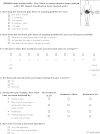Report of the NIH Task Force on research standards for chronic low back pain
- PMID: 25639530
- PMCID: PMC5396149
- DOI: 10.2522/ptj.2015.95.2.e1
Report of the NIH Task Force on research standards for chronic low back pain
Abstract
Despite rapidly increasing intervention, functional disability due to chronic low back pain (cLBP) has increased in recent decades. We often cannot identify mechanisms to explain the major negative impact cLBP has on patients' lives. Such cLBP is often termed non-specific and may be due to multiple biologic and behavioral etiologies. Researchers use varied inclusion criteria, definitions, baseline assessments, and outcome measures, which impede comparisons and consensus. Therefore, NIH Pain Consortium charged a Research Task Force (RTF) to draft standards for research on cLBP. The resulting multidisciplinary panel recommended using 2 questions to define cLBP; classifying cLBP by its impact (defined by pain intensity, pain interference, and physical function); use of a minimum dataset to describe research participants (drawing heavily on the PROMIS methodology); reporting "responder analyses" in addition to mean outcome scores; and suggestions for future research and dissemination. The Pain Consortium has approved the recommendations, which investigators should incorporate into NIH grant proposals. The RTF believes that these recommendations will advance the field, help to resolve controversies, and facilitate future research addressing the genomic, neurologic, and other mechanistic substrates of chronic low back pain. We expect that the RTF recommendations will become a dynamic document and undergo continual improvement.
Perspective: A task force was convened by the NIH Pain Consortium with the goal of developing research standards for chronic low back pain. The results included recommendations for definitions, a minimum dataset, reporting outcomes, and future research. Greater consistency in reporting should facilitate comparisons among studies and the development of phenotypes.
Keywords: Low back pain; NIH Task Force; chronic low back pain; minimum dataset; research standards.
© 2014 by the American Pain Society. Reprinted from: Deyo RA, Dworkin SF, Amtmann D, et al. Report of the NIH task force on research standards for chronic low back pain. J Pain. 2014;15(6):569-585, with permission from Elsevier Inc/American Pain Society.
Figures
References
-
- Accessing PROMIS Short Form Instruments. Available at: http://www.assessmentcenter.net/PromisForms.aspx Accessed February 2, 2014
-
- PROsetta Stone: Linking Patient-Reported Outcome Measures. Available at: http://www.prosettastone.org Accessed February 2, 2014
-
- Institutes of Medicine: Relieving Pain in America: A Blue-print for Transforming Prevention, Care, Education, and Research. Washington, DC, The National Academies Press, 2011 - PubMed
-
- Abraham I, Killackey-Jones B: Lack of evidence-based research for idiopathic low back pain: the importance of a specific diagnosis. Arch Intern Med 162:1442–1444, 2002. discussion 1447 - PubMed
MeSH terms
Grants and funding
LinkOut - more resources
Full Text Sources
Other Literature Sources
Medical


